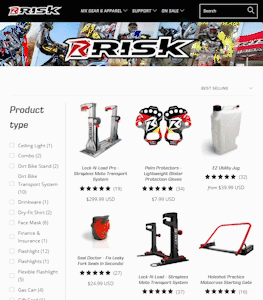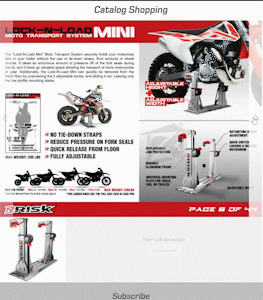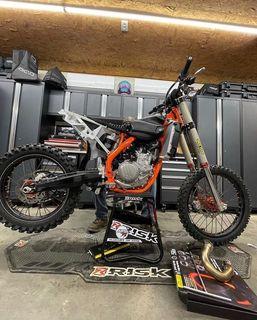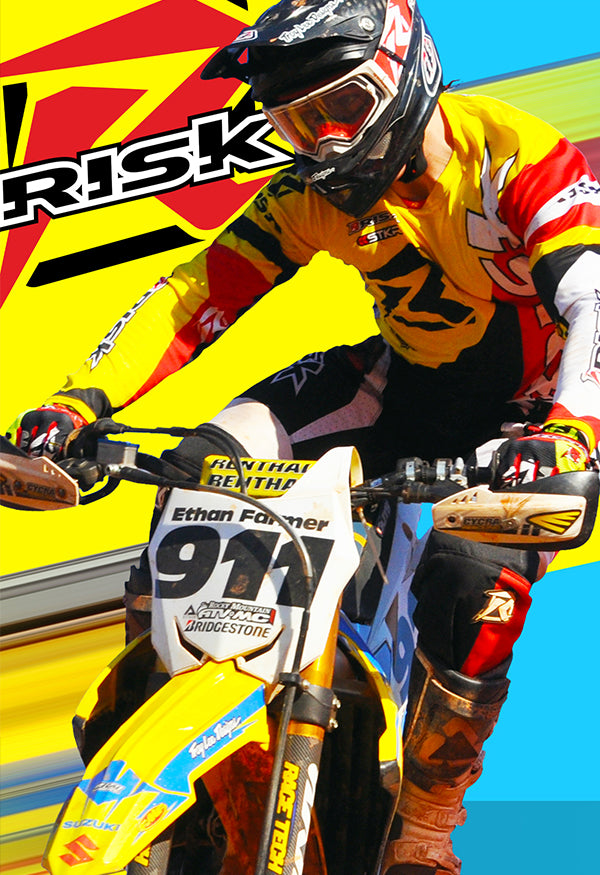Tu carrito está vacío
MOTO Products
shop your way
Choose a shopping experience
Same great Risk Racing products, 3 completly different ways to shop them.
Choose a shopping experience
Same great Risk Racing products, 3 completly different ways to shop them.

Lifestyle Shopping

eComm Shopping

Catalog Shopping
MOTO TYRES
MOTO Gear & Apparel
What is the Basic Maintenance for a Dirt Bike?
diciembre 10, 2021 10 lectura mínima

Dirt bikes are known to last almost a lifetime. But that’s not going to happen if you don’t take care of it and maintain it properly.
Unlike regular motorcycles, dirt bikes are frequently subjected to tons of mud, dirt, and pressure brought about by the terrain it explores. While anyone can argue that the dirt bike is designed for these harsh conditions, it’s no excuse to skip the fundamental maintenance requirements.
Basic maintenance for a dirt bike includes regular cleaning and washing, parts replacement or refill, oil change, visual inspection for damages, tire pressure check, etc.
You can opt for professional maintenance, especially if your dirt bike is used in racing competitions.
Nevertheless, you can do most of these maintenance procedures on your own, provided that you have suitable materials on hand.
If you want to learn the how's and whys of a dirt bike’s basic maintenance, read on as we walk you through the process.

Do Dirt Bikes Require a Lot of Maintenance?
The level of maintenance required for a dirt bike depends on how frequent and intense you use it.
If you are riding daily on tracks or terrains that are extremely challenging, then you should expect high maintenance of your dirt bike.
On the other hand, if you’re riding the dirt bike conservatively or using it just on occasion, naturally, you can settle for low maintenance.
Nevertheless, regardless of how long or hard you ride your dirt bike, it is still recommended to inspect it after every use.
The mere fact that off-road riding presents hazards at least twice as much as street riding is enough reason to have routine checkups on your bike.
Damages Dirt Bikes Can Sustain From Lack of Maintenance
The dusty, uneven terrain can cause more than a scratch or two to your dirt bike if you don’t maintain it well. This can be aggravated if you’re riding in the rain or treading a watery terrain.
1. Mechanical damage from prolonged exposure to water
If by any chance you ride on some wet tracks or trails or while it is raining, you should check your dirt bike as soon as you get back to your shop or garage.
There are many mechanical moving parts that are more exposed like the chain and sprocket. These need to stay clean and lubricated to perform optimally.
2. Corrosion and rapid deterioration
Water damage and mud sticking to the dirt bike for a long time can lead to chemical reactions that promote corrosion.
If you don’t clean up and check the condition of your dirt bike, you will find rust in no time. With that, you can expect some parts to deteriorate faster than the others.
3. Scratches and chipping from mud attachment
Aesthetics may not seem like a big deal to some riders knowing full well that dirt bikes are more about functionality. But in racing competitions such as motocross and arenacross, it can boost morale to keep your bike looking at its best.
That’s why you shouldn’t take for granted the scratches, let alone dents sustained during a ride. Plus, it’s not just about cosmetic damage. These minor defects can worsen if not fixed in time.
Aside from the damages your dirt bike can get, poor maintenance can also increase your risks for injuries.
Tires filled with mud from your previous rides can lead to decreased tire traction, which can affect your ability control the bike.
To keep the mud at a minimum during a wet or rainy riding day, make sure to bring along a cleaning tool like the Mud Axe.
What Kind of Maintenance Does a Dirt Bike Need?
A dirt bike has the same basic maintenance needs as a regular motorcycle, but the frequency of servicing varies.
Moreover, replacements of several parts are after a shorter period of use. Perhaps this comparison is why people are convinced that dirt bikes are high maintenance.
Nonetheless, these maintenance services are crucial for keeping the optimum condition and function of the dirt bike. So, it’s time to take note of the following parts of dirt bike maintenance.
1. Washing
It’s never a good decision to let your dirt bike stay covered in muck for a long time. And by that, we mean letting the mud, dirt, and dust stick to your bike after a ride.
Materials Used for Washing a Dirt Bike
You can easily wash your dirt bike, especially if you use a pressure washer. This cleaning equipment makes it easier to remove mud, grime, and dirt all over your dirt bike.
Of course, when cleaning dirt bikes, you have to consider several tips that will preserve your unit during the process.
For starters, make sure you have a stand for your dirt bike when you do the washing. Placing the entire unit on a stand makes it a whole lot easier to reach corners and curves filled with clumpy mud and dirt.
If you haven’t purchased a stand yet, check out our Ride-On MX Stand or ATS adjustable top stand. These sturdy stands are lightweight, durable, and create a solid work area for you to clean and work on your dirt bike.
Likewise, use a mat like Risk Racing’s Factory Pit Mat placed under the stand to catch the spills maintaining the stability of your dirt bike and the cleanliness of your washing area.
To sum it up, here are the items you need:
- Pressure Washer
- Dirt Bike Stand
- Pit Mat
- Mild Detergent
- Finishing Towel
How To Wash Your Dirt Bike
When all the necessary materials are ready, take the following tips in cleaning your dirt bike.
- Manually remove large chunks of dried mud. Use a Mud Axe to dig out mud and dirt stuck in crevices.
- Avoid sticking the pressure washer’s nozzle on the bike’s airbox (without an airbox wash cover), electronic parts, wheel bearings, countershaft, and chain. This could lead to corrosion which will destroy the inner parts of your bike.
- Make sure your pressure washer is under 3,000 PSI.
- Maintain a 2 to 3 feet distance between the nozzle and the dirt bike. It can prevent any physical damage caused by the pressure.
- Do not use abrasive cleaners, or else you will damage the plastic and other softer parts of your dirt bike.
- Dry off your dirt bike after washing using a dry towel to prevent extended contact with water. You can also use an air compressor or a leaf blower, especially on nooks and crevices.

2. Air Filter Cleaning
You can never underestimate the importance of an air filter in your dirt bike engine’s overall health.
Air filters allow proper air circulation needed for the engine to function. For fuel to combust, it has to be mixed with sufficient air.
So, if your air filter is filled with dirt, gunk, and dust, your engine will work twice as hard to draw air and process the fuel, which can be a huge waste of energy.
On top of that, it could significantly block the carburetor and ruin the piston in the long run.
If you’re a casual rider, you should clean your air filter before it gets dirty. However, for riders and those who are riding tracks with heavy dust and muck, air filters should be cleaned every after use. Simply remove dirt and debris using a specific air filter cleaning agent.
On average, the air filter should be replaced every 2 to 4 rides. But this could vary depending on the dirt bike model and how hard you have been riding your bike and the type of terrain you like to ride on.

3. Routine Checkup for Brake Pads
Brake pads are not meant to last forever. So naturally, they will be worn out after a certain amount ride time.
The front brake is responsible for 70% of the dirt bike braking system, which means that it should be inspected regularly.
If damage has been spotted on your brake pad, it has to be fixed as soon as possible. On the other hand, you can detect if the brake pad is exhausted if the friction material is visibly worn out.
If you choose not to change it, you might be risking mechanical failure which can compromise your safety.
For example, your brakes can be binding, or the entire bike will pulse when you hit the worn-out pad.
Fortunately, you can easily replace the brake pad yourself. And in doing so, don’t forget to check your service manual to get the right pads and materials.
4. Engine and Fork Oil Change
Engine oil should be changed every 3 hours of dirt bike riding. If your track or terrain is filled with dust and grime, change your engine oil sooner.
Like the air filter, worn-out dirty oil and obstructed oil filter will affect engine function – and not in a good way.
If you’re wondering why dirt bikes need to undergo an oil change quicker than a regular motorcycle, this is because dirt bikes are constantly exposed to tons of dirt that can contaminate the oil easily, and are typically ran at higher RPM's for longer. As a result, the oil loses its lubrication qualities faster, affecting the motion of engine parts.
Another oil driven component that needs your attention is your forks and shock. If your dirt bike has an oil-driven front fork, don’t forget to keep those forks clean and have the oil changed if necessary. Just like the engine oil, the oil in your forks can get dirty and inhibit the function of your suspension.
To keep your fork seals clean from dirt and debris trying to get in between the seal and the tube and create leaks, make sure you have a handy Seal Doctor in your toolset. This small device slides up into your fork seals and pulls out any unwanted particles leaving a nice clean seal.
What Are the Signs That You Need an Oil Change?
Visual inspection can easily tell you if you’re due for an oil change. The color of the oil is similar to brown honey. You will have to change the oil if it’s darker than that. Usually, it becomes black or gritty.
Moreover, if the engine is making too much noise, it’s a sign that an oil change is due. The lack of lubricity leads to engine parts bumping and grinding on one another.

5. Chain Tension Check and Lubrication
You may overlook issues with your dirt bike chain until it’s too late. And that’s certainly one situation you should avoid.
While it is understandable that the chain is maybe not the first thing you think about checking, assessing its physical condition is crucial for securing your riding safety.
For one, there is the probability that the chain becomes loose. This incorrect chain tension can lead to several damages involving your sprocket. It could also lead to spontaneous snapping during the ride, which can actually endanger your safety.
To tighten your dirt bike chain, all you need is a large crescent wrench, a bike stand, grunge brush, and chain lube. Start by loosening the nut on the axel, followed by the locknuts.
Then turn the tension bolt out until it is properly tightened. Repeat the process on the other side.
Aside from tightening the chain tension, don’t forget to clean and lubricate the chain.
Place the dirt bike on the stand and grab your degreaser and brush. Spray the chain with the degreaser and use the brush to spread the solution.
6. Sprocket Replacement
The chain and sprocket of your dirt bike wear out over time and after regular use. Sprockets can be replaced together with the chain.
Regardless of how long you’ve been riding your dirt bike, if the chains start to loosen or degrade and the sprockets thin or have wear spots, you will have to replace them.
Nonetheless, if you regularly clean and lube your chains, the lesser the probability of a major and frequent sprocket and chain replacement.

7. Wheel Maintenance and Tire Pressure Check
Wheels are crucial parts of your dirt bike’s performance and function. To ensure that you are properly maintaining your wheels’ optimal condition, make sure that you clean and wash them after use.
Likewise, check the tire pressure at regular intervals. The average range of tire pressure runs from 8 to 16 psi with 12 psi as the average.
You may have to alter your tire pressure from time to time, especially if you’re riding on different terrain types.
Moreover, check for any damage on the tire tread that could affect traction.
8. Pre-ride Fluid Check
The likelihood of accidents increases when the dirt bike is not checked before riding. This includes checking fluid levels that impact your dirt bike’s performance altogether. Make sure the following fluids are sufficient:
- Oil level
- Coolant level
- Brake fluid level
- Gas level
9. Visual Inspection and Leak Checks
Looking for damages on your dirt bike need not be complicated. A simple visual inspection can even suffice.
Check for any dents, tears, wear-offs, loosened nuts, spokes, and bolts, and repositioned levers. If these conditions are present, make sure to have them fixed first before riding your dirt bike.
Although these damages may seem minor, if not acted upon immediately, they can lead to critical defects that might put you in danger during your next ride.
Likewise, check for fluid leaks, especially the coolant and gas. Leaking coolant can indicate problems with the engine, so make sure you address it right away.
Create a checklist for your visual inspection and integrate it into your pre-ride dirt bike assessment.

How Often Do You Need to Service a Dirt Bike?
Complete servicing encompassing part replacements has to be done at least once a year. That is, if you have been using your dirt bike conservatively. Otherwise, you need to book an overall dirt bike servicing after 10 hours of use.
As a rule of thumb, you should visually inspect your bike before and after every use. This way, you can immediately identify any damage or need for a quick fix.
However, specific services have their own regularity. Take the following schedule, for example.
- Filter servicing – every after 3 to 4 hours (this goes shorter if you’re riding under dusty conditions)
- Oil service – every after 3 to 4 hours
- Valve inspection – every after 20 hours
- Grease bearings – every 20 hours
Several factors may affect how often you need to service a dirt bike. It’s always best to refer to your dirt bike manual as manufacturers may have different recommendations on maintaining your specific unit.
In a Nutshell
Taking good care of your dirt bike means becoming responsible for its maintenance. Otherwise, you may be looking at a deteriorating investment.
To ensure that your dirt bike is consistently reliable, always do a pre-ride and post-ride inspection. Likewise, be mindful of what needs to be replaced and cleaned every ride. Keep a schedule of the servicing necessary and always check for damages. Minor defects should not be neglected.
Take immediate action and keep in mind that your dirt bike can last for a long time only if you maintain it properly.

Dejar un comentario
Los comentarios se aprobarán antes de mostrarse.
Subscribe
Sign up to get the latest on sales, new releases and more …

Limited Time 10% Off
Save on your 1st order and get email offers when you join.
Eligible for first-time website purchases only. Emails may take a few minutes to process and could get flagged by email providers as junk so be sure to wait a little bit and check your junk and/or spam folders.

 Reino Unido / EU▾
Reino Unido / EU▾
































